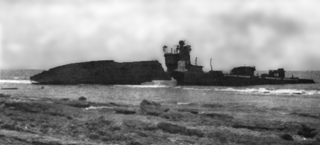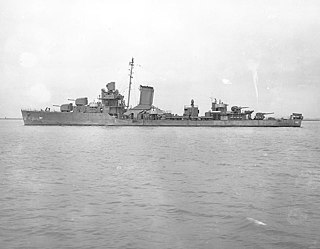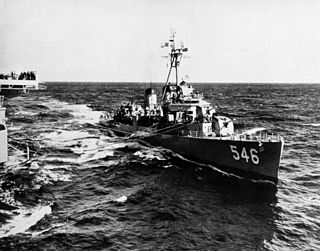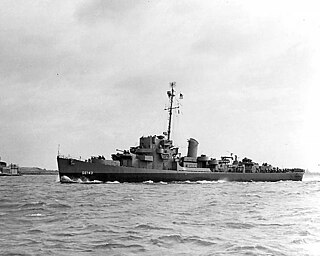See also
- Battle of Wake Island, an early World War II battle for the island
- USS Wake, a WW2 ship named for Wake Island
Wake Island is an atoll in the Pacific Ocean. It may also refer to:

Wake Island is a coral atoll in the Micronesia subregion of the northwestern Pacific Ocean. The atoll is composed of three islets and a reef surrounding a lagoon. The nearest inhabited island is Utirik Atoll in the Marshall Islands, located 592 miles to the southeast. The United States administers Wake Island as an unorganized and unincorporated territory, and it is one of the nine insular areas that comprise the United States Minor Outlying Islands. The Marshall Islands also claim Wake Island.

The Mare Island Naval Shipyard (MINSY) was the first United States Navy base established on the Pacific Ocean. It is located 25 miles (40 km) northeast of San Francisco in Vallejo, California. The Napa River goes through the Mare Island Strait and separates the peninsula shipyard from the main portion of the city of Vallejo. MINSY made a name for itself as the premier U.S. West Coast submarine port as well as serving as the controlling force in San Francisco Bay Area shipbuilding efforts during World War II.

The United States Pacific Fleet (USPACFLT) is a theater-level component command of the United States Navy, located in the Pacific Ocean. It provides naval forces to the Indo-Pacific Command. Fleet headquarters is at Joint Base Pearl Harbor–Hickam, Hawaii, with large secondary facilities at Naval Air Station North Island, California.
Two ships of the United States Navy have been named Bennington, after the town of Bennington, Vermont. The Battle of Bennington occurred on 16 August 1777.

USS Enterprise (CV-6) was a Yorktown-class carrier built for the United States Navy during the 1930s. She was the seventh U.S. Navy vessel of that name. Colloquially called "The Big E", she was the sixth aircraft carrier of the United States Navy. Launched in 1936, she was one of only three American carriers commissioned before World War II to survive the war. She participated in more major actions of the war against Japan than any other United States ship. These actions included the attack on Pearl Harbor — 18 Douglas SBD Dauntless dive bombers of her air group arrived over the harbor during the attack; seven were shot down with eight airmen killed and two wounded, making her the only American aircraft carrier with men at Pearl Harbor during the attack and the first to sustain casualties during the Pacific War — the Battle of Midway, the Battle of the Eastern Solomons, the Battle of the Santa Cruz Islands, various other air-sea engagements during the Guadalcanal Campaign, the Battle of the Philippine Sea, and the Battle of Leyte Gulf. Enterprise earned 20 battle stars, the most for any U.S. warship in World War II, and was the most decorated U.S. ship of World War II. She was also the first American ship to sink a full-sized enemy warship after the Pacific War had been declared when her aircraft sank the Japanese submarine I-70 on 10 December 1941. On three occasions during the war, the Japanese announced that she had been sunk in battle, inspiring her nickname "The Grey Ghost". By the end of the war, her planes and guns had downed 911 enemy planes, sunk 71 ships, and damaged or destroyed 192 more.

Raymond Ames Spruance was a United States Navy admiral during World War II. He commanded U.S. naval forces during the Battle of the Philippine Sea, one of the most significant naval battles of the Pacific Theatre. He also commanded Task Force 16 at the Battle of Midway, comprising the carriers Enterprise and Hornet. At Midway, dive bombers from Enterprise sank four larger carriers of the Imperial Japanese Navy. Most historians consider Midway the turning point of the Pacific War.

The Yorktown class was a class of three aircraft carriers built for the United States Navy and completed shortly before World War II, the Yorktown (CV-5), Enterprise (CV-6), and Hornet (CV-8). They immediately followed Ranger, the first U.S. aircraft carrier built as such, and benefited in design from experience with Ranger and the earlier Lexington class, which were conversions into carriers of two battlecruisers that were to be scrapped to comply with the Washington Naval Treaty, an arms limitation accord.

USS Wake (PR-3) was a United States Navy river gunboat operating on the Yangtze River. Originally commissioned as the gunboat Guam (PG-43), she was redesignated river patrol vessel PR-3 in 1928, and renamed Wake 23 January 1941. She was captured by Japan on 8 December 1941 and renamed Tatara. After her recapture in 1945, she was transferred to Chinese nationalists, who renamed her Tai Yuan. Communist forces captured her in 1949. On 1 May, 1949 Tai Yuan was sunk by Nationalist aircraft in the Caishiji River.

USS Northampton (CL/CA-26) was the lead ship in Northampton-class cruiser, in service with the United States Navy. She was commissioned in 1930, originally classified a light cruiser because of her thin armor but later reclassified a heavy cruiser because of her 8-inch guns. During World War II she served in the Pacific and was sunk by Japanese torpedoes during the Battle of Tassafaronga on 30 November 1942. She was named after the city of Northampton, Massachusetts, the home of former President Calvin Coolidge.

VFA-31 or Strike Fighter Squadron 31 is known as the Tomcatters, callsign "Felix", a United States Navy strike fighter squadron stationed at Naval Air Station Oceana flying the F/A-18E Super Hornet. The Tomcatters are the second oldest Navy Fighter Attack squadron operating today.

The Battle of Wake Island was a battle of the Pacific campaign of World War II, fought on Wake Island. The assault began simultaneously with the attack on Pearl Harbor naval and air bases in Hawaii on the morning of 8 December 1941, and ended on 23 December, with the surrender of American forces to the Empire of Japan. It was fought on and around the atoll formed by Wake Island and its minor islets of Peale and Wilkes Islands by the air, land, and naval forces of the Japanese Empire against those of the United States, with Marines playing a prominent role on both sides.

USS Burns (DD-588), was a Fletcher-class destroyer, the second ship of the United States Navy to be named for Captain Hugh Otway Burns (1775–1850), a privateer in the War of 1812.

Marine Fighter Attack Squadron 211 (VMFA-211) is a United States Marine Corps fighter attack squadron, currently consisting of F-35B Lightning II stealth STOVL strike fighter jets. Known as the "Wake Island Avengers" and the "Bastion Defenders", the squadron is based at Marine Corps Air Station Yuma, Arizona and falls under the command of Marine Aircraft Group 13 (MAG-13) and the 3rd Marine Aircraft Wing.

USS Blue (DD-387), a Bagley-class destroyer, was the first United States Navy ship of that name, in honor of Rear Admiral Victor Blue (1865–1928). Blue served during World War II. She was launched 27 May 1937 by Norfolk Naval Shipyard; sponsored by Miss Kate Lilly Blue, sister of Rear Adm. Blue; and commissioned 14 August 1937.

USS Brown (DD-546) was a Fletcher-class destroyer of the United States Navy, named for George Brown, a seaman on the crew of USS Intrepid during the raid that destroyed the captured USS Philadelphia in Tripoli harbor during the First Barbary War. Entering service in 1943 during World War II, the ship saw active service until 1962 when she was decommissioned and sold to Greece. Renamed Navarinon, the destroyer was active until 1981 when she was sold for scrap.

USS John Rodgers (DD-574) was a Fletcher-class destroyer of the United States Navy commissioned during World War II and the second ship to bear the name. She was named after three members of the Rodgers family who served in the Navy from the War of 1812 through World War I. John Rodgers served in several wartime actions in the Pacific, receiving 12 battle stars.

Sadamichi Kajioka was an admiral in the Imperial Japanese Navy during World War II. He directed Japanese forces involved in the Battle of Wake Island.

USS Fiske (DE-143) was an Edsall-class destroyer escort built for the United States Navy during World War II. Named for Rear Admiral Bradley Allen Fiske, she was the first of two U.S. Naval vessels to bear the name. The vessel entered service in 1943 and served in the Atlantic Ocean during World War II as part of a hunter-killer anti-submarine group. On 2 August 1944, Fiske was sunk by a torpedo fired by the German submarine U-804. Thirty-three of the ship's crew were killed and a further 50 were injured.

USS Hilbert (DE-742) was a Cannon-class destroyer escort in service with the United States Navy from 1944 to 1946. She was sold for scrapping in 1973.

USS Plumas County (LST-1083) was an LST-542-class tank landing ship in the United States Navy. Unlike many of her class, which received only numbers and were disposed of after World War II, she survived long enough to be named. On 1 July 1955, all LSTs still in commission were named for US counties or parishes; LST-1083 was given the name Plumas County, after Plumas County, California.